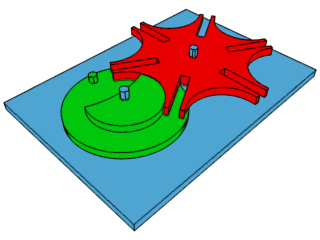An implantable wheel-like hydrogel Geneva drive uses a motorized magnet to move independently. Image: Sau Yin Chin
If you've ever seen anybody endure chemotherapy, you know that it can be a grueling process, to say the least. But new research on tiny, 3D-printed, jelly-like robots could provide an alternative to flooding the body with poison: popping the robots inside the body to target the cancer directly. It's an exciting development that shows the possibilities of robots that can both run automatically and deliver medicine more precisely than current methods.Samuel Sia and his colleagues at Columbia University wanted to create an implantable device that was totally biocompatible—made of materials that don't disrupt or damage living tissue—according to the research published in Science Robotics this week. They decided to use hydrogels, a type of synthetic material that has a high water content and can be adjust to be soft like human tissue or stiffer like rubber. Devices like this have been made before, but they usually also include some non-biocompatible parts to make the whole thing run, like batteries. But these little robots were designed to be totally biocompatible and self-sufficient: no batteries required.First, the researchers had to create a method of production, so they built a custom 3D printer that could easily build up layers of hydrogels to make the little robots. A typical 3D printer would take hours to make a similar device, because the hydrogel material is a bit sloppy to work with. But their hydrogel printer made a complex mechanism in just 30 minutes.They made several designs but the one they tested most thoroughly was a hydrogel Geneva drive: a type of gear used in watchmaking that precisely ticks along at certain degrees: Instead of a battery powered motor, the device can be activated by a magnet placed on the skin, which tugs on a very tiny amount of gel-coated iron in the center of the drive. The idea is that a doctor could implant the device exactly where a patient needs medicine delivered, but no doses would come out until the doctor or patient activated the gear with a magnet.To test out whether this would be feasible in an actual living creature, the researchers loaded the Geneva drive with tiny doses of doxorubicin—a chemotherapy drug used to treat bone cancer—and inserted it under the skin of lab mice that had cancerous bone tumors. They found that, compared to mice that received a standard treatment of chemotherapy, the Geneva drive was more effective at slowing growth of the tumor, killing tumor cells, and caused less damage to healthy cells.Though it's only been tested in mice so far, Sia's research marks a number of exciting advancements, from the speedy 3D printing technique, to the fully biocompatible device, that could open the door for all kinds of new medical devices. Sia's team even writes that the device could be made biodegradable, meaning a doctor wouldn't need to extract it when treatment is over: the robot could just dissolve away.Compared to the way we douse patients with chemotherapy now, a little jelly robot would be a major upgrade.
Instead of a battery powered motor, the device can be activated by a magnet placed on the skin, which tugs on a very tiny amount of gel-coated iron in the center of the drive. The idea is that a doctor could implant the device exactly where a patient needs medicine delivered, but no doses would come out until the doctor or patient activated the gear with a magnet.To test out whether this would be feasible in an actual living creature, the researchers loaded the Geneva drive with tiny doses of doxorubicin—a chemotherapy drug used to treat bone cancer—and inserted it under the skin of lab mice that had cancerous bone tumors. They found that, compared to mice that received a standard treatment of chemotherapy, the Geneva drive was more effective at slowing growth of the tumor, killing tumor cells, and caused less damage to healthy cells.Though it's only been tested in mice so far, Sia's research marks a number of exciting advancements, from the speedy 3D printing technique, to the fully biocompatible device, that could open the door for all kinds of new medical devices. Sia's team even writes that the device could be made biodegradable, meaning a doctor wouldn't need to extract it when treatment is over: the robot could just dissolve away.Compared to the way we douse patients with chemotherapy now, a little jelly robot would be a major upgrade.
Advertisement

